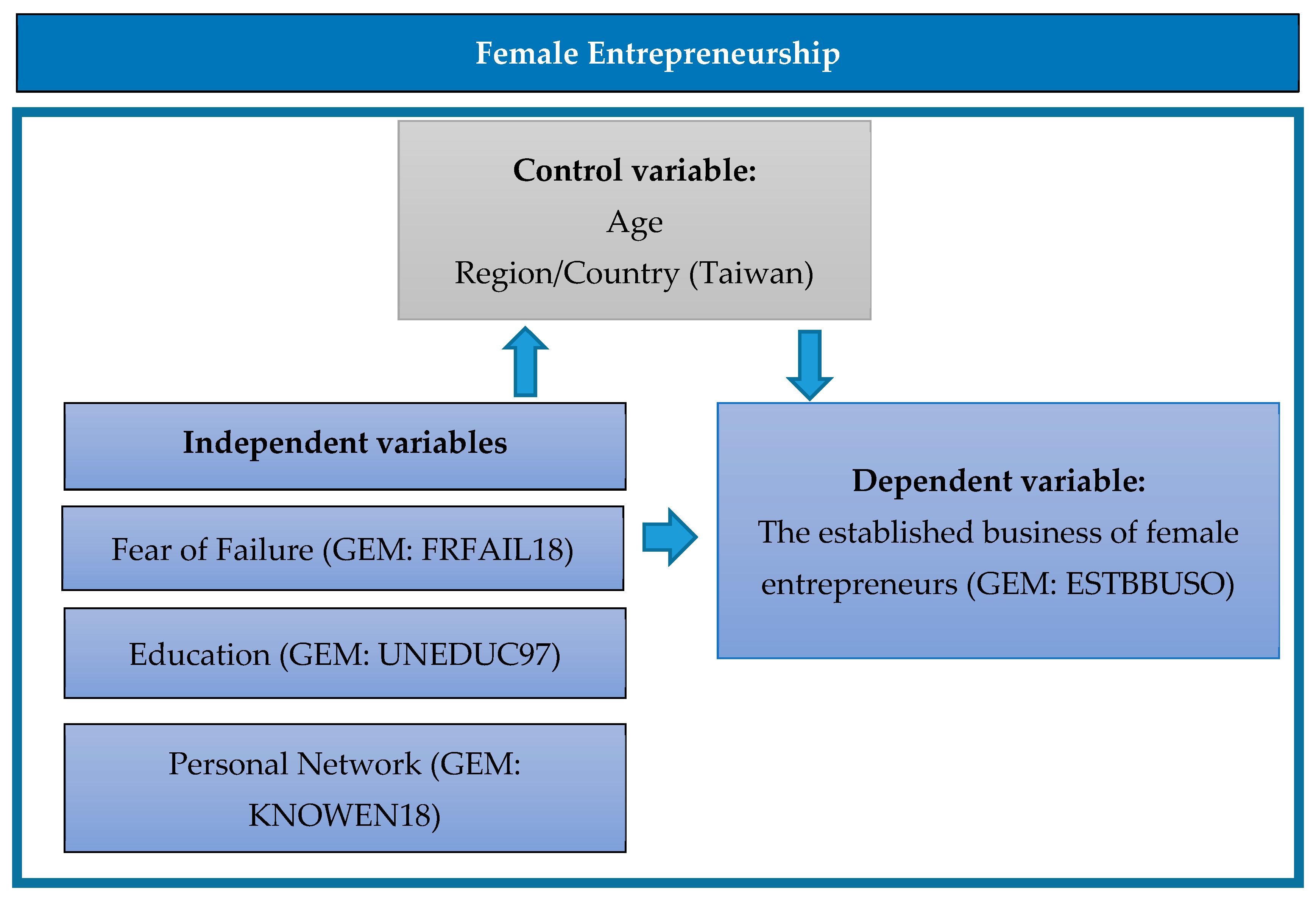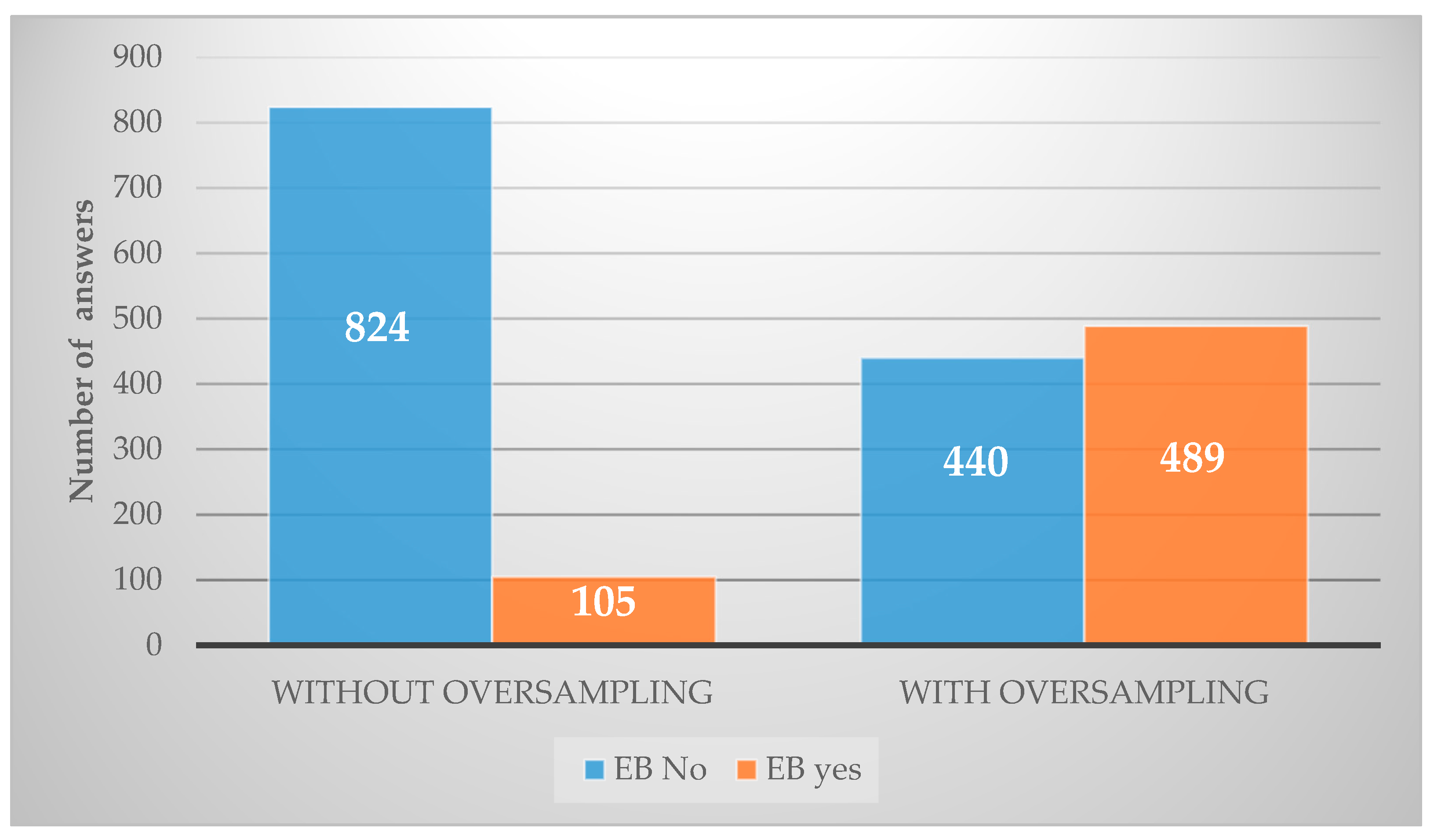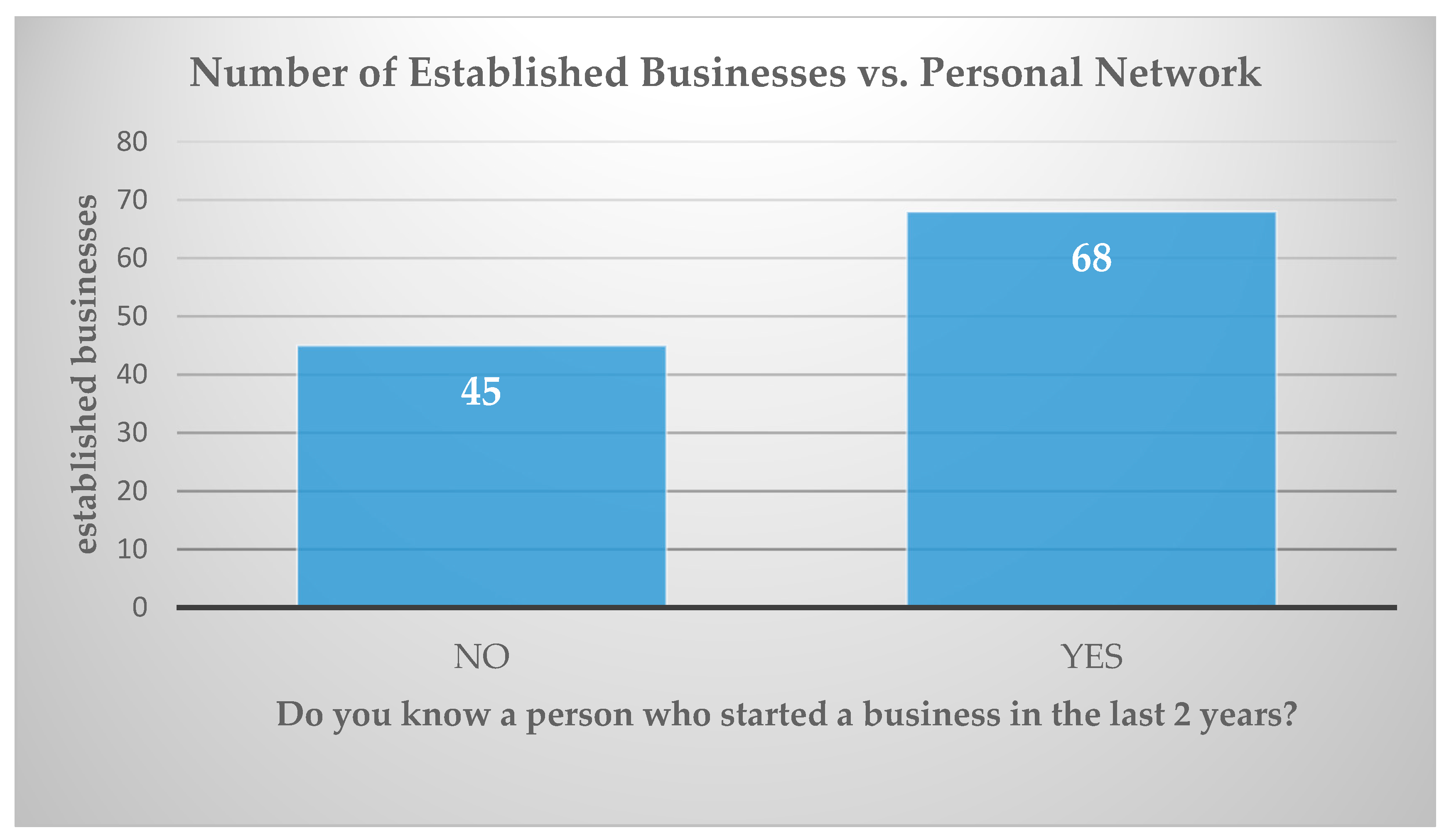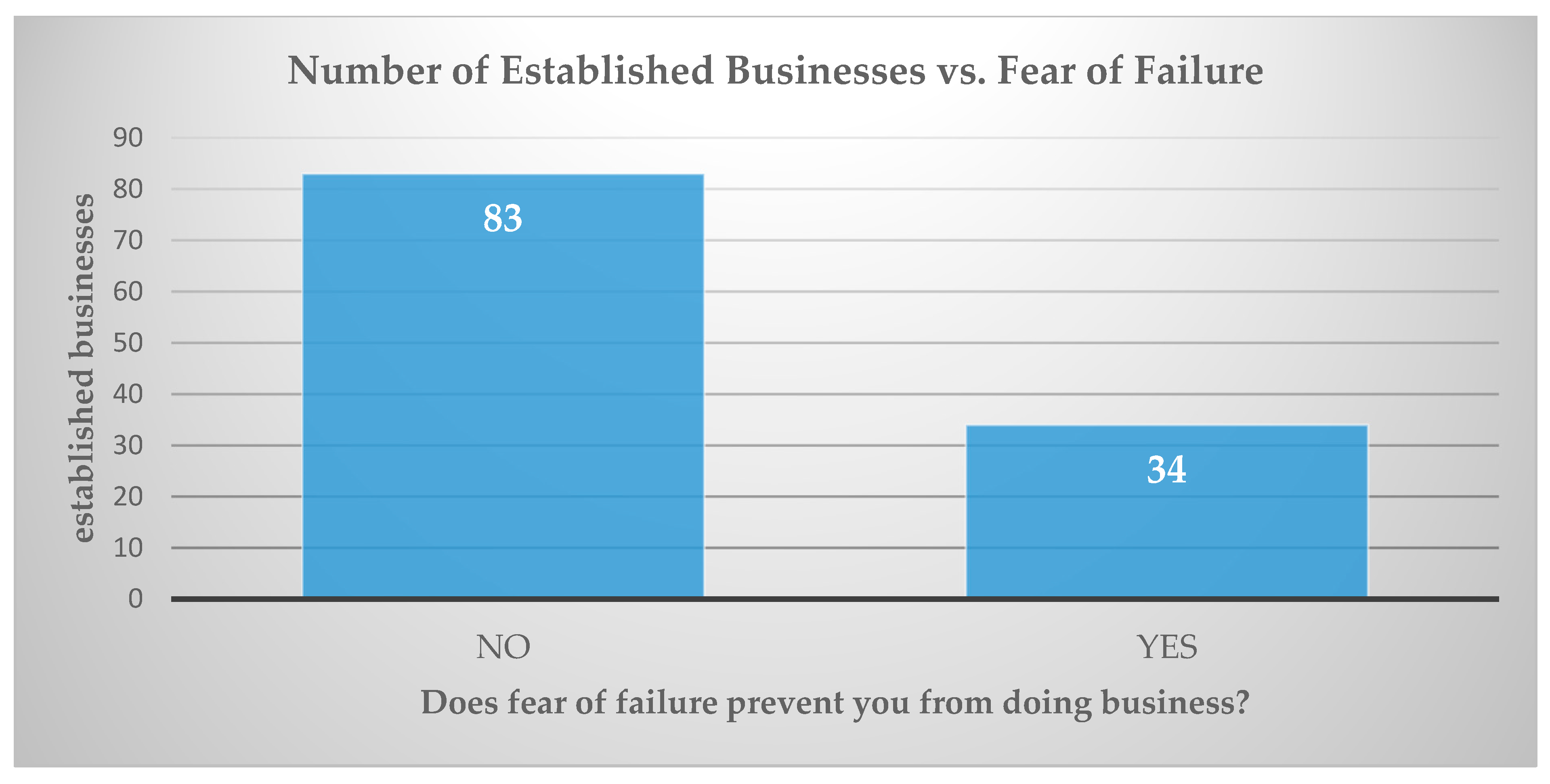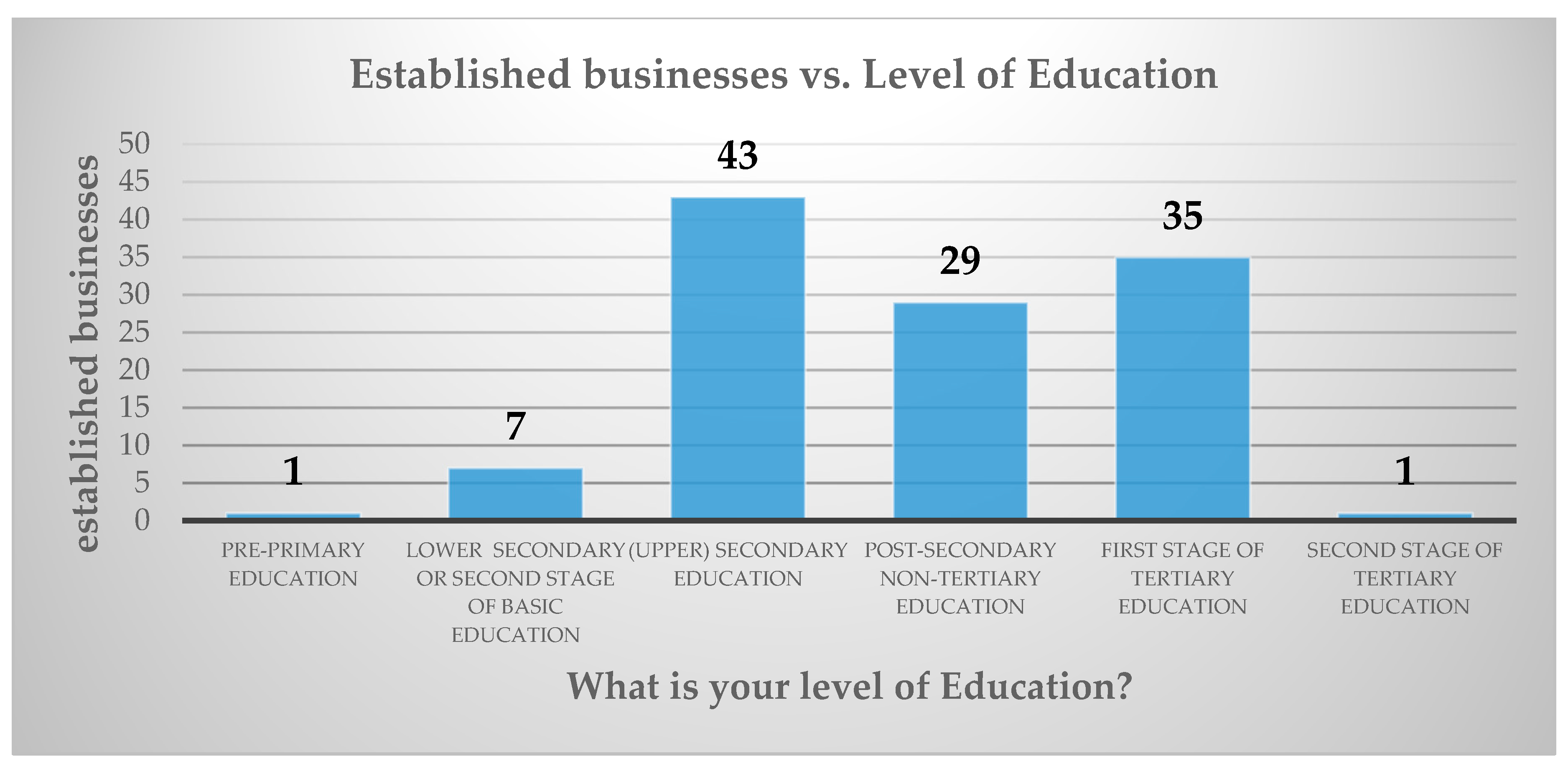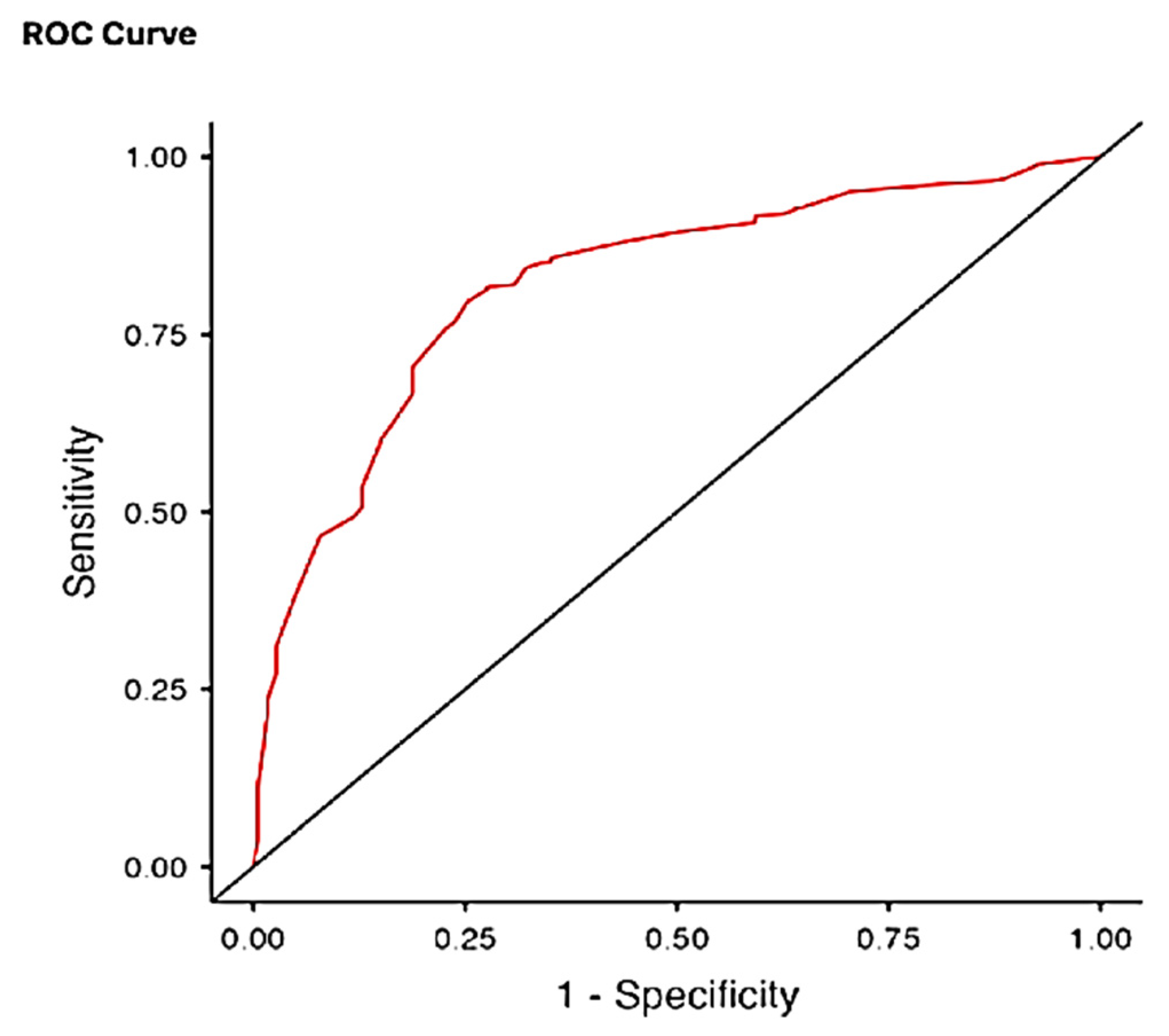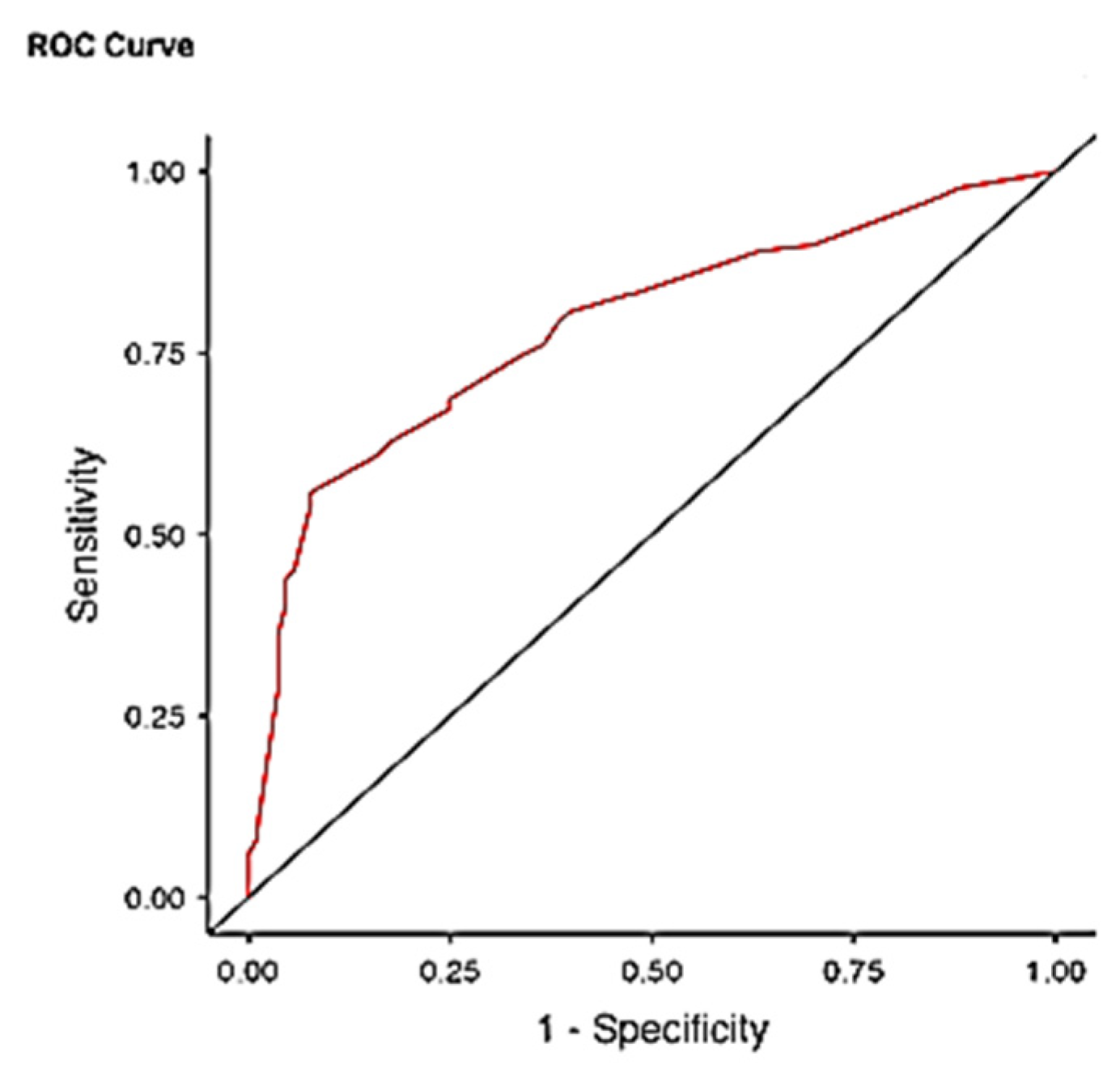1. Introduction
Around the globe, it is still the case that fewer women than men are becoming entrepreneurs [
1,
2]. The gender gap is 14% in low-income economies, and in the middle- and high-income regions/countries, the ratio shows with 26% a much higher gap [
3]. Several reasons for the gap are covered in the literature, like socioeconomic characteristics, fewer years of experience, cultural background, and discrimination issues [
4,
5]. Concerning established businesses, which run more than 42 months, 6.2% of female entrepreneurs own such businesses and 9.5% of male entrepreneurs from a global view. The higher the national income in a region/country, the higher the gender gap in established businesses. Some factors might have a different effect on women’s established businesses’ success than men’s [
3].
The promotion of female entrepreneurial activity is widespread among organizations like the World Bank, the Organization for Economic Cooperation and Development (OECD), and the World Trade Organization (WTO). According to the Morgan Stanley Capital International (MSCI) and the Financial Times Stock Exchange (FTSE) classification, Taiwan can be considered an emerging economy. According to various statistics, Taiwan made tremendous signs of progress according to the number of female-owned businesses, and therefore, the importance is increasing when it comes to entrepreneurship success among women. The FEI of Taiwan in 2015 scored 53.4, which is a very high value, and it got ranked in 26th place out of 77 [
6,
7]. It is crucial to shed light on female-owned businesses and to support them because, on the one hand, it empowers women, and on the other, it leads to poverty reduction and economic growth [
8].
Compared to developed economies, women in emerging economies, especially in low-income regions/countries, are often more self-confident concerning their skills and doing their own business, shown in
Figure 1 below. It visualizes the established business rate, which means that the business is at least 42 months old, which indicates the success of a business. A low established business rate harms the overall entrepreneurship and slows economic growth [
3]. Established business ownership rate refers to the percentage of the 18–64 population who are currently owner-manager of an established business, i.e., owning and managing a running business with paid salaries, wages, or any other payments to the owners for more than 42 months [
9].
In the Middle East and Asia, gender disparity is a huge problem, and this issue is getting reduced by the expansion of entrepreneurship [
10]. In Taiwan, more than 36% out of 1.46 million entrepreneurs are owned by women, and more than 51% of those businesses have a survival time of more than ten years, according to the “White Paper on Small and Medium Enterprises in Taiwan, 2016” [
11]. Taiwan is well-known for many small- and medium-sized enterprises, where many women are involved, contributing to the labor market and developing the economy. Therefore, more governmental policy support for female business owners must be provided [
12].
To sum it up, when it comes to female entrepreneurship in emerging markets, it is clearly shown that two main problems/challenges are existing:
Women tend to start businesses with lower growth and profit expectations;
Unemployment and gender disparity are huge issues, especially in high-income regions/countries like Taiwan.
The paper investigates how economic growth could be achieved by increasing the number of successful female entrepreneurs due to the mentioned theoretical facts. Therefore, some factors are going to be analyzed to find out which factors have an impact on the established business rate among female entrepreneurs in Taiwan.
Much research exists on highly-developed economies, but studies on female entrepreneurship in emerging markets are scarce, especially those primarily focusing on Taiwan. Entrepreneurship is essential to drive economic growth, and so it is essential to shedding light on the creation of businesses by female entrepreneurs to highlight the value that female entrepreneurs bring to global societies and enhance further growth. Especially in emerging economies, it is the main contributing factor to social progress and the economy as a whole, and it is an essential driver for the industrial competitiveness and opportunities of employment [
2,
13,
14].
According to the literature, more intensive research is suggested regarding the correlation between personality traits and entrepreneurial activity, focusing on the factors influencing the established business rate to determine relevant success factors [
12]. Most of the literature analyzed factors responsible for a successful business start, but less research was found on the factors affecting an already successful, established business, which is at least 42 months old [
15].
The following research question will be answered by combining secondary and primary data:
“What factors contribute significantly to female entrepreneurs’ business success in Taiwan?”
To limit the research, not all issues will be analyzed. Therefore, male-dominated entrepreneurship and general basics about entrepreneurship are not the subject of that paper and will not be described in detail since the empirical part will only focus on female entrepreneurs’ success factors in Taiwan.
3. Materials and Methods
3.1. Conceptual Framework
A research framework illustrated in
Figure 3 had to be developed. It helps the authors focus on the scope and to reach the objectives by defining and identifying different variables and is usually connected to the research question [
27]. The whole research is focused on female entrepreneurs so that the research will take place within that frame. The research data will be analyzed by logistic regression, where the influence and the relationship between one dependent and various independent variables will be tested. The independent variables will be changed, and the change’s impact will be measured with the dependent variable. Therefore, the authors chose various success factors, which seemed very relevant according to the literature review. Those factors are the independent factors that might influence the dependent variable. The dependent variable is called established businesses of female entrepreneurs, where data from the GEM database is retrieved. It has to be noticed that each relationship between one independent and the dependent variable has to be tested separately because some might have an influence in a negative way and some in a positive way. It is also necessary to identify some control variables, which may influence the outcome, and they need to be controlled and stay constant. The control variables the authors identified are age and region/country. The advantage of taking care of control variables is that the research’s reproduction can be done more straightforwardly, and the research results’ confidence is increasing [
28].
3.1.1. Source of Data
The study’s subject was the participants of the Adult Population Survey (APS) from the GEM database. To get the data only from the target group, the database was filtered to get only female participants from Taiwan, aged between 18 and 64. In total, the database includes 1098 observations of women in Taiwan and 117 interviews.
3.1.2. Data Analysis
Due to limitations, not all factors could have been analyzed by the authors. Therefore, some specific factors were chosen, which were also found in various other scientific papers and journals. Furthermore, the data analysis was mainly based on a secondary metadata-analysis, and therefore it is essential that data about these factors could be extracted from the GEM database, which is used for the data analysis. For the analysis and the interpretation, the statistical tool “R” was used. The logistic linear regression model was used to identify the relationship between one or more independent variables and one dependent variable. Oversampling was also used while a dataset was not balanced, and the answers of the dependent variable were dominated by one single value, which might manipulate the data analysis. Therefore, it was essential to modify and balance the data to use the dataset for the statistical analysis.
3.2. Hypotheses
In general, entrepreneurship is determined by several success factors, which were described in the sections above. This paper will focus on some specific success factors of an established business to test them concerning female entrepreneurship and individual region/country-level. The following section will explain the motives that drive female entrepreneurs’ success.
3.2.1. Education
According to the literature, professional experience and education are essential success factors for entrepreneurship and have a massive influence on entrepreneurial skills and self-employment. On the one hand, it leads to the acquisition of specific qualifications. On the other hand, it is about the stimulation of unique characteristics concerning one’s initiative and self-control to get the ability and courage to implement one’s ideas and thoughts—more or fewer self-employment opportunities mark certain occupational areas. The choice of a particular occupation is already a preliminary decision for or against self-employment [
29].
A curriculum that integrates entrepreneurial subjects is widespread nowadays to raise awareness of entrepreneurship’s possibilities and opportunities. Especially in institutions on a secondary or tertiary level, skills, knowledge, and attitudes about entrepreneurship are transferred. Through that approach, entrepreneurial mindsets, thoughts, and talents are getting fostered, leading to a reduction of entrepreneurial barriers [
30].
The entrepreneurial skills could be distinguished between the learnable qualifications and between certain personality traits, which have a high degree of stability over time. Especially the variety and the structure of qualifications are relevant for successful entrepreneurship. According to literature research, it could be assumed that a positive correlation between the educational level and the probability of having a business is existing [
28]. Mainly, nowadays, it could be observed that women with higher educational levels are more focused on self-employment [
11].
Most female entrepreneurs in Taiwan are educated with primary and secondary education and are aged between 30 and 40 [
11]. According to Hofstede’s cultural dimension “Masculinity vs. Femininity,” Taiwan can be assigned to a slightly feminine culture because it has a relatively low score of 45, which means that people are somewhat motivated by doing their task because they like it, instead of trying to be better than the others. The culture appreciates more the quality of life [
16].
Therefore, the following hypothesis could be formed:
Hypotheses (H1). The factor “level of education” is significantly correlated to business success among females in Taiwan.
3.2.2. Risk Awareness and Fear of Failure
Fear of failure is a factor that exists among both genders. Nevertheless, the degree of fear of failure is much higher among women. When it decides the expansion of the business by women, factors like risk aversion, lack of awareness of own competencies, and the aspiration of a work-life balance often hinder that decision. Due to the higher degree of fear of failure, female entrepreneurs tend to grow businesses longer and do not want to expand their businesses quickly. For women, it is essential to limit the size of a business to some extent in order to be able to manage and control the business with their available resources and skills and their desire for a work-life balance, so their risk propensity is relatively low. Besides the progress on gender equality, it is still the case that women are getting discriminated against at the workplace and feel they need to take care of the household and their family. That is why many women enjoy a business’s ownership because that helps them get out of that stereotypical thinking and enables them to become more independent. Changing from an employee to a business owner is a crucial step when it comes to self-realization. The decision to own and expand a business is determined by a lot of personality traits and challenges. When women start a business, they show that they can overcome those barriers, and according to literature, it can be assumed that a higher degree of freedom on taking the risk and creating its working style can be reached [
31].
Cities in Taiwan, which have a more considerable amount of men, show a higher number of self-employed because of better financial support and a higher awareness of risk. Furthermore, in Taiwan, the self-employment rate is very high in the following sectors according to the data from 2017: service and sales (38%), agriculture and forestry (25%), craft- and machine-operation (25%). That is why it is more difficult for females in Taiwan to own a business because men usually dominate the mentioned sectors. Differences in the labor market can be observed when comparing developed countries in the European Union (EU) [
31]. According to the cultural dimensions of Hofstede, it is shown that Taiwan has a substantial degree of uncertainty avoidance with a score of 69, which indicates that the people with that culture do not feel comfortable when it comes to unknown or ambiguous situations, and they try to avoid them [
16].
Based on the theoretical findings, the following hypotheses were formed:
Hypotheses (H2). The factor “fear of failure” is significantly correlated to business success among females in Taiwan.
3.2.3. Personal Network
When it comes to the start or expansion of female businesses, family and friends’ support plays an important role. The acknowledgment of the idea by people, who are in a close relationship with female business owners, is of high value [
11]. Influences from outside and from the family are affecting the decision-making processes of women. Therefore, it can be assumed that personal contacts and role models are favorable to female entrepreneurs’ business success [
11]. The importance of family members or team members in the decision-making process also indicates that women have a more collaborative leadership style, and when it comes to achieving goals, teamwork is preferred by women. Informal networks for sharing information and resources among various enterprises are standard in female-owned businesses [
12].
Considering Hofstede’s cultural dimensions, Taiwan has a collectivistic culture with a score of 17, which means that loyalty plays a crucial role, and healthy relationships are fostered [
15]. In developing countries/regions, like China and Taiwan, social status is often a challenge among female entrepreneurs because they play a crucial role in entrepreneurial intentions. In many cases, the problem is that the family opposes new ventures because they had negative experiences with female entrepreneurship [
11].
Therefore, the following hypotheses can be assumed:
Hypotheses (H3). The factor “personal network” is significantly correlated to business success among females in Taiwan.
3.3. Research Design
The literature review in the theoretical part built the basis for the empirical part and was needed to form the hypotheses tested by the authors through secondary data analysis. The literature review aimed to analyze significant determinants of female entrepreneurs’ business success in Taiwan to answer the research questions and the results analyzed by the authors with a metadata-analysis. The central database for the quantitative research was the freely accessible GEM database 2018/2019, which intends to analyze and report the entrepreneurial environment of 49 individual economies every year [
32]. The sample size includes at least 2000 adults in every economy. The National Expert Survey (NES) is based on at least 36 experts for assessing the conditions of the creation of entrepreneurship in each economy. The database enables a region/country comparison on a high level, as it provides a detailed insight on different entrepreneurial types and phases (GEM Global Entrepreneurship Monitor, n.d.).
To answer the research questions and hypotheses, variables from the GEM database were extracted, reflecting the mentioned factors of education, fear of failure, personal network, opportunity perception, entrepreneurial skills, and role models to analyze their influence on the established business rate.
The study subjects were the participants of the Adult Population Survey (APS) from the GEM database. To get the data only from the target group that should be focused on in this paper, the database was filtered to get only female participants from Taiwan, aged between 18 and 64. In total, the database includes 1098 observations of women in Taiwan and 117 interviews.
For the analysis and the interpretation, the statistical tool “R” will be used. To identify the relationship between variables, the logistic linear regression model was used to determine if a prediction of the established businesses is possible through the various independent factors [
33]. For example, in the case of that paper, the binary dependent variable would be the variable “established businesses,” which can be either 0 for “No, the person is not an established business owner,” or 1 for “Yes, the person is an established business owner,” like in some other research [
34,
35].
To determine the factors of successful businesses of female entrepreneurs, together with some differences between females in emerging and developed economies, a secondary metadata-analysis was used, which has already been collected by the GEM-consortium. With that type of research, existing theories are used and are proven by the authors through the secondary data analysis, and therefore, hypotheses have to be formed. For that research approach, mainly external secondary data were used by the authors. Secondary research saves time and helps prepare the primary research, and it also provides additional relevant information. Although secondary data analysis has many advantages, some disadvantages also need to be considered. The purpose of the collected data is often deviating from the purpose of the current research, which could lead to a lack of relevance and accuracy. With Google Scholar, scientific articles and journals with a VHB Ranking of at least D were analyzed to get sufficient secondary data. Besides, some expert interviews were carried out to support and prove the findings and get some additional insights. The experts were chosen to discuss the results analyzed by the authors. Therefore, one expert from the GEM research team in Austria and one expert from the Taiwan team were interviewed.
3.4. Data
As already mentioned in the chapters above, the database for the secondary metadata-analysis is the GEM database. It provides entrepreneurial data of different regions/countries and analysis on entrepreneurial characters and inspirations. GEM can be considered one of the best initiatives regarding the research of entrepreneurial perceptions and attitudes among several regions/countries [
3].
To be able to answer the research questions and hypotheses of that thesis, variables from the GEM database were extracted, which reflect the mentioned factors of education, fear of failure, and personal network.
3.4.1. Dependent Variable
The variable established business ownership “ESTBBUSO” will be used as the indicator of success in that master thesis and is therefore used as the dependent variable and identifies people managing and owning a business that is aged more than 42 months. It is a binary scaled variable with two levels. 0 means “No established business owner,” and 1 means “Established business owner.”
3.4.2. Independent Variables
The independent variables which are used to predict the established business owners are mainly nominally scaled variables and were recoded to binary variables by removing answers like “Do not know,” “Refused,” and “Not Answered” because they are not relevant for the analysis. It means that the variables’ value can be 0 for “No” and 1 for “Yes.” Except for “UNEDUC97”, scaled ordinally with seven different educational levels, which were summarized by the authors in two categories: 0 for “lower education” and 1 for “higher education” by looking at the number of established businesses in each category and by splitting it into two categories to have approximately the same number of answers in both categories. The following table gives an overview of which success factors were chosen and how they are going to be connected to the data from the GEM database, as shown in
Table 1.
3.5. Logistic Regression Model
The binary logistic regression analysis investigates the relationship between the probability that the dependent variable takes the value 1, which means “Yes, the person is an established business owner,” and the independent variables. So, it has to be mentioned that the dependent variable’s value is predicted, but it is predicted that the dependent variable takes the value 1 [
36].
The following conditions have to be fulfilled when logistic regression is used:
The dependent variable is binary (either 0 or 1).
The independent variables need to be metric or binary dummy variables.
For each group formed by categorical predictors, n ≥ 25.
The independent variables are not positively correlated with each other.
The logistic regression model is based on maximum-likelihood estimation. Like the linear regression model, the logistic regression analysis tries to find a curve that fits the data well. The function is not linear. It is “s-shaped” symmetrical and runs asymptotically towards y = 0 and y = 1. This means that the logistic function only takes values between 0 and 1 [
37].
The following formula is behind the logistic regression model:
P: the probability that the dependent variable (y) is 1.
e: the basis of the natural logarithm, Euler’s number.
z: linear regression model of the independent variable, which is also called logit.
- ○
xk: independent variable.
- ○
βk: regression coefficient, which shows if the independent variable is negatively or positively correlated to the dependent variable.
- ○
ε: error value, which measures the difference between the value predicted by the regression line for the test person and the measured value for the test person.
After inserting the relevant variables, the following formula can be used:
The formula calculates how likely the independent variables can predict the value of a dependent variable. The value of the likelihood function can also be used to estimate the model quality and model significance. The p-value and the chi-square value for the whole model have to be analyzed to test its significance. When the value is below 0.05, it indicates the statistical significance, and the null hypothesis can be rejected. The Wald test shows the significance of each factor and is necessary to test the hypotheses for each factor, and it is helpful to find out which factors should not be integrated into the model because they are not statistically significant. The goodness of the fitness of a model is going to be tested with the R-square value. In the logistic regression analysis, the Negelkerke R-square value is standard and is between 0 and 1, and the closer the value is at 1, the better the model fits the regression, and it shows how close the variability of the data is around the mean.
Due to limitations regarding this paper’s scope and the limited amount of available data, not all factors can be part of the study. Therefore some socio-cultural factors from the FEI were chosen, which were also found in various other scientific papers and journals [
38,
39,
40].
The data analysis will be mainly based on secondary metadata-analysis, and therefore, it is essential that these factors could be extracted from the GEM database, which is used for the data analysis. Of course, there are much more factors that relate to entrepreneurial business success; however, at this point, the focus shall remain on the matters relevant to the scope of this paper and leave other issues open for further discussions and researchers.
The study’s subject is the Adult Population Survey participants (APS) from the GEM database. The database was filtered to get only female participants from Taiwan and Austria, aged between 18 and 64. In total, the database includes 1098 observations of women in Taiwan and 2270 female participants from Austria.
The variable established business ownership “ESTBBUSO” was used as the indicator of success and is therefore used as the dependent variable and identifies people managing and owning an older enterprise than 42 months. It is a binary scaled variable with two levels. 0 means “No established business owner,” and 1 means “Established business owner.”
The independent variables which are used to predict the established business owners are mainly nominally scaled variables and were recoded to binary variables by removing answers like “Do not know,” “Refused,” and “Not Answered” because they are not relevant for the analysis. It means that the variables’ value can be 0 for “No” and 1 for “Yes.” Except for the variable “UNEDUC97”, which is scaled ordinally with seven different educational levels, other variables were summarized by the authors in two categories: 0 for “lower education” and 1 for “higher education” by looking at the number of established businesses in each category and by splitting it into two categories to have approximately the same number of answers in both categories. The following table gives an overview of which success factors were chosen and how they are going to be connected to the data from the GEM database as shown in
Table 2.
3.6. Oversampling
Oversampling is used if a dataset is not balanced, and the answers of the dependent variable are dominated by one single value, which might manipulate the data analysis. Therefore, it is essential to modify and balance the data to use the statistical analysis dataset. It means that the number of records of the minority class is increased. In contrast to the oversampling technique, the undersampling technique balances the data by reducing the majority class. The oversampling technique was chosen because no data is getting lost, and all binary values are kept. It means that the number of “Yes” answers is increased through the oversampling technique so that a balance between answers is produced. The random oversampling uses random participants with “Yes” answers, which are added and duplicated to the latest training dataset, as shown in
Figure 4. The oversampling technique is only used to train the model. Otherwise, it would manipulate the results [
41].
3.7. Target Group
The study’s subject is the Adult Population Survey (APS) from the GEM database. To get the data only from the target group, the database was filtered to get only female participants from Taiwan, aged between 18 and 64. In total, the database includes 1098 observations of women in Taiwan.
5. Results and Discussion
In order to analyze if the number of established businesses of females in Taiwan can be predicted through the mentioned factors of fear of failure, educational level, personal network, role model, opportunity perception, and entrepreneurial skills, the logistic regression model was built in Jamovi, and the following results (
Figure 8) arose after oversampling the data.
To examine each coefficient’s significance, the system performed the Omnibus Likelihood Ratio Test with the following relevant results in the columns “chi-square” and “p.”
It shows that the independent variables like “knowent,” “suskill,” “opport,” and “UNEDUC97” have a
p-value which is below 0.001, which is an indicator for a statistical significance when it comes to the relationship between dependent and independent variables. Concerning the factor “nbstatus,” the
p-value is considered rather high with a value of 0.329, indicating no statistical significance. Therefore, the factor “nbstatus” is going to be excluded from the model. The AIC value and the
p-value 0.329 show that the variable “nbstatus” does not increase the quality of the prediction, and therefore the model without that variable will be preferred, as shown in
Table 3.
The regression coefficient and the odds ratios show that “yes” answers of the personal network (“knowent”) have a positive effect on the number of established businesses as well as the “yes” answers of the factor entrepreneurial skills (“suskill”) and therefore might increase the number of established businesses. The coefficient of fear of failure shows that “Yes” answers negatively influence the established business and decrease the number of established businesses.
The regression with the variable educational level shows a result in
Table 4 with a negative coefficient too, which indicates that a higher educational level is negatively related to the number of established businesses and opportunity perception (“opport”).
Regarding the overall model analysis, the
p-value shows that the model can be defined as significant because the value is below 0.05, and a relationship between independent and dependent variables can be assumed, as shown in
Table 5 and
Table 6. When checking the model fit, different R-square tests are performed by the system to assess how well the regression model explains the dependent variable. The pseudo R2 of Negelkerke can take values between 0 and 1. The closer the value is to 1, the better the regression. For the present research, the value of the Negelkerke R-square is 0.343.
The classification is shown by looking at the table below, which gives an overview of how much of the predicted values were correctly predicted by the system. It is visible that around 77% of the values were correctly classified, which can be considered as a better prediction than one that is done by accident, as shown in
Table 7.
The ROC curve of that model shows that it is not very close to the diagonal, and the area under the curve is around 80%. It means that the model’s fitness can be considered between the categories “acceptable” and “excellent.”
To analyze if Austria’s results differ from Taiwan’s results, the following paragraphs will summarize the empirical findings through Austria’s logistic regression model.
The “chi-square” value and the “
p-value” of each factor are shown in the figure below, and it is visible that the significance values of the Austrian model are similar to the values of the Taiwanese model, and the variable “nbstatus” can also be considered as not significant and has to be excluded from the model, as shown in
Table 8.
After reducing the model by removing the insignificant factor “opport,” the regression coefficients of the independent variables are analyzed in order to be able to understand how the independent variables are affecting the number of female established businesses in Austria. As it is shown in the figure below, the variables “suskill,” “knowent” and “UNEDUC97” and “nbstatus” are positively affecting the established business rate, and the variable “fearfail” is decreasing the number of established businesses when female entrepreneurs in Austria responded with “yes, as indicated in
Table 9.”
Regarding the overall model analysis, the
p-value shows that the model can be defined as significant because the value is below 0.05, and a relationship between independent and dependent variables can be assumed, as shown in
Table 10 and
Table 11.
The multicollinearity test shows that the variables are not strongly correlated because the VIF value is below 2.5.
Austria’s overall model analysis shows that the model is significant with a very low p-value, and the Negelkerke R-square value is 0.338.
Referring to the Austrian model’s prediction, the accuracy score is around 71.6%, and the area under the curve is 78.6%. That means that the model fit is excellent, which could also be seen in the ROC curve, as shown in
Table 12.
To answer the following research question: “Which factors contribute significantly to female entrepreneurs’ business success in the outperforming emerging market in Taiwan?”, the following main findings were elaborated.
5.1. Influence of the Educational Level
According to the literature, most female entrepreneurs in Taiwan are educated in middle-level primary and secondary education [
12]. After analyzing some descriptive statistics, it can be assumed that the literature assumption is correct because the educational level was mainly on the (upper) secondary education among the female participants.
Nevertheless, not enough evidence was found against the H0 hypotheses, and was not statistically significant, for the correlation between education level and business success. Therefore, H1 cannot be confirmed because no statistically significant evidence was found for the alternative hypothesis H1, and the following assumption could be made:
Hypotheses (H0). The factor “level of education” is not significantly correlated to business success among females in Taiwan, as shown in Figure 9. 5.2. Influence of Fear of Failure
As mentioned in various articles and journals, fear of failure is a relevant factor in female entrepreneurship in Taiwan. It harms business success because women with a high degree of fear of failure do not have a high-risk propensity [
31]. A significant correlation between fear of failure and business success was examined with the statistical test, and therefore, the alternative hypothesis H1 can be verified, and the H0 hypothesis can be rejected:
Hypotheses (H1). The factor “fear of failure” is significantly correlated to business success among females in Taiwan.
5.3. Influence of Personal Network
As mentioned in the literature review, the probability of being an entrepreneur increases when people have an entrepreneurial network around them for the perception of the entrepreneurial skills because women are less confident concerning their skills than men [
22].
According to the research findings of this paper, the following hypotheses can be accepted because H0 can be rejected since enough statistically significant evidence was given:
Hypotheses (H1). The factor “personal network” is significantly correlated to business success among females in Taiwan.
According to the statistical analysis and the statistical tests, it is evident that two out of three factors, which were chosen from the literature, do significantly contribute to the business success of female entrepreneurs. When it comes to the fear of failure, it can be assumed that the fear of failure of women will have a negative influence on the success of a business of female entrepreneurs in Taiwan, which means that the probability of owning an established business is getting reduced, when fear of failure exists. Furthermore, a female entrepreneur’s network is also an essential and significant success factor of an established business because the number of participants who have connections to other business owners is positively related to the established business.
Nevertheless, it has to be noticed that some of the factors are influencing business success to a certain degree. However, it is not possible to predict the business success based on merely those factors, as it could be seen in the classification table, where only 62% of all values were predicted correctly and the “Negelkerke R2 value” has a relatively low value of 0.1040776 which means that the goodness of the model fit is medium. Nevertheless, it is more expressive than the Null-Model, where none of the mentioned predictors would be included.
6. Conclusions
This paper aims to analyze the relationship between various factors and a female entrepreneur’s success by looking at the number of established businesses from the GEM database and how it is related to the success factors of educational level, personal network, and fear of failure. A logistic regression model was examined for testing the hypotheses, and the following statements can be drawn:
According to the literature, professional experience and education are essential success factors for entrepreneurship and have a massive influence on entrepreneurial skills development and the tendency to self-employment [
29]. That assumption was not statistically significant because not all women can achieve such a high level of education in Taiwan and it is unusual to get a very high degree of education because it is costly. Furthermore, the literature often stated that females in Taiwan are doing their own business to realize themselves and differentiate from the stereotypes of who should be in the household and take care of the family. This is a rather personal decision, not necessarily connected to education level [
30]. Nevertheless, entrepreneurial education shall be focused on various education stages because it is an excellent opportunity for females’ self-fulfillment, strengthening self-confidence. It is even possible to have a successful business without a high degree of education, and that should be focused on because it is more about the willingness and the desire for self-realization [
31]. This is also visible in the cultural dimensions of Hofstede, where Taiwan is considered a relatively “feminine” society, where people work for a living. It has to be noted that the results might change when the influence of the educational levels of only one age group is tested. Due to Taiwan’s rapid development, it might be that the educational level of the younger generation who is owning an established business is much higher than it was 20 years ago [
31].
When the expansion of the business is decided by women, factors like fear of failure and lack of awareness of own competencies often hinder that decision [
31]. Of course, fear of failure is not only a barrier for female entrepreneurs. It is also something that could hinder male entrepreneurial success. Nevertheless, it has to be noticed that men are usually more self-confident and do not have so much pressure from society concerning childcare. The significant correlation between fear of failure and established businesses might be rooted in the cultural background. In Asian culture, it is expected that people do not want to “lose one’s face.” In this cultural context, this means that they are not risk-averse because they do not want to make mistakes, and they are not very self-confident when it comes to their skills because losing one’s face means losing the reputation in that culture [
19]. Furthermore, the highly scored cultural dimension, “Uncertainty Avoidance,” of Taiwan also shows that this culture does not like uncomfortable or risky situations [
16].
The importance of having a personal network connected with successful entrepreneurship was often underlined by theory, and the correlation can also be confirmed through that research. Informal networks for sharing information and resources among various enterprises in female-owned businesses are standard. This is also why women often prefer a leadership style based on teamwork [
12]. It can also be justified with the cultural dimensions because Taiwan’s culture is rather collectivist and not an individualist society, which means that people in Taiwan feel more comfortable in groups and take care of each other [
16].
Several literature findings can reason the low accuracy score of the model. Many scientists believe that it is impossible to develop a conclusive theory that describes why some start-up projects fail, whereas other young companies succeed in growing in the long term [
23]. A uniform understanding does not exist of how or by what the company’s success is determined by, neither in the external nor internal success factor of research. Therefore, it is nearly impossible to find one formula for female entrepreneurs’ business success [
26].
This paper aimed to investigate how economic growth could be achieved by increasing the number of successful female entrepreneurs. After an extensive literature review of scientific articles and journals, connections to the hypotheses were built, and the authors tested them by using the GEM database. It was very challenging because the database was vast, and many variables were included, so it was challenging to identify precisely those variables needed for the research. The study subjects were the participants of the Adult Population Survey (APS) from the GEM database. To get the data only from the target group that should be focused on in this paper, the database was filtered to get only female participants from Taiwan, aged between 18 and 64. In total, the database includes 1098 observations of women in Taiwan and 117 interviews.
Nevertheless, after the whole data cleaning process, exciting findings were researched regarding female entrepreneurs’ success factors in Taiwan. It can be concluded that 2/3 of the factors, which were analyzed, had a statistically significant contribution to business success. The cultural dimensions of Hofstede of Taiwan were used to justify the findings. For female entrepreneurs’ business success in Taiwan, it is essential to encourage them to grow and expand their business by taking away their fear of failure because having some risk propensity is essential for expanding the business.
Furthermore, women must get much support from their environment, like family, friends, and employees. Personal networks play an essential role in the development of skills among women. Therefore, it might also help to foster networking between various female entrepreneurs in Taiwan to exchange their entrepreneurial experiences and share their thoughts. This might increase their confidence and motivation. The level of education does not directly contribute to female business success in Taiwan, and this result might have cultural reasons. We would also encourage all female entrepreneurs to read this paper because it can help them understand the theory. After all, this might be reflected in their thoughts and feelings. If women know how to react to their needs and desires, solve some problems, and even know the reasons behind them, their awareness of their skills will increase. It will encourage and motivate them to keep doing their business and will support them in being successful.
Nevertheless, it has to be noticed that many other influencing factors have to be considered when defining a thriving business among female entrepreneurs in Taiwan.
After reflecting on feminist liberal and social theories and the female awareness of entrepreneurial competencies, analyzing some success factors provides a better and more in-depth understanding of female entrepreneurship in Taiwan. These insights can be used for further research to compare those findings with other regions/countries.
Nevertheless, the research is limited to just a few factors, and a more detailed analysis of additional success factors, for example, access to financial resources or level of innovation, is recommended.


